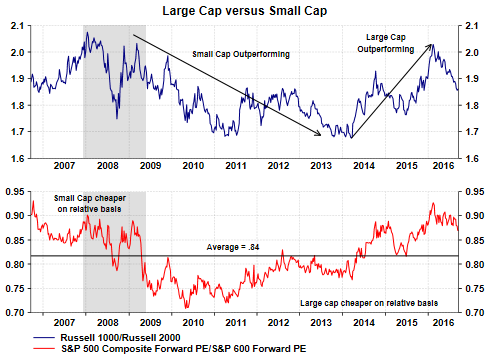Heightened Market Volatility Would Favor Low Volatility Strategy, But It Looks Expensive
A little more than a year ago we wrote about the outperformance of the low volatility strategy versus a more risk on/high beta strategy. At that time it was noted low volatility could persist; however, if the broader market reached new highs, the high beta strategy would likely outperform low volatility. This has essentially played out and as the calendar turned to 2016 the early year market pullback saw the high beta strategy succumb to significant selling pressure and was down 20% into the February low, almost twice the broader market's beginning of year decline. Once the market began recovering from the February low though, high beta has outperformed the low volatility strategy, 25% versus 9%, respectively.


Obviously there are significant differences in the composition of the low volatility ETF (SPLV) and the high beta ETF (SPHB). For example, the low volatility strategy has nearly 24% of its equity allocation invested in the utility sector versus no utilities exposure in the high beta strategy. In the high beta strategy, 34% of its allocation is in the energy sector while the low volatility strategy has no energy allocation. In fact, seven of the top ten holdings in SPHB are energy names and a number of these energy positions have seen out sized market returns since the February low.

Another area of the market that has seen 'risk on' outperformance is in the small cap area of the equity market. Again, since the market bottom in February, small cap has outperformed large cap by 600 basis points. Playing to small caps favor is the relative valuation of small cap is cheaper than large cap; however, both small and large stocks are trading at elevated valuation levels.


As I have noted in several earlier posts, these valuations are not at levels seen during the tech bubble days. Earnings have been depressed due to the negative impact of currency exchange/translation and the negative impact from the energy sector both contributing to a lower E, or earnings, in the P/E ratio. Both energy and currency headwinds are projected to subside as one looks out over the next twelve months with currency headwinds already lessening on a year over year basis.
S&P 500 year over year earnings growth is anticipated to be low double digits in the back half of 2017. Admittedly, the second half of 2017 is a long way off, especially when the market is laser focused on tomorrow, but even high single digit growth would likely be viewed positively by the market and this has a high probability of being realized, all else being equal.

Lastly, with a great deal of investor focus on income yielding investments and asset classes, as the below chart shows, those market segments have actually lagged since the end of February.

The issues facing investors seems threefold.
- At the moment the calendar is in a seasonally volatile period for equities. The increased volatility exhibited by the market over the last week is not surprising, and throw in the political calendar, this creates potential market moving headlines too.
- The Fed is meeting this coming week and the recent increase in 'market' interest rates is leading a few strategist to suggest this opens the door for a Fed rate increase this week, i.e., the market is pricing in an increase already. The difficulty is the fact the Fed is behind the curve in normalizing rates in our view and seems intent to raise them simply to get the rate to a more neutral level regardless of some of the weak, albeit positive, economic data.
- The traditional defensive equity market sectors seem priced for perfection. As the below chart shows, utilities and consumer staples are trading at high valuations and high PEGs as well. More detail on the PEG ratio can be found in one of our earlier articles, A Look At The PEG Ratio: Earnings Growth Versus Valuation. The defensive sectors may not be as defensive as investor expect.

With a two day Fed meeting this week, elevated market volatility for both stocks and bonds is highly probable. Much of the sentiment data is trending less bullish and it seems a lot of this weekend's commentary is suggestive of a market pullback, like here and here. One positive factor though is the fact the market historically has not incurred a significant correction when everyone is positioned for one or expecting one. We continue to favor areas of the market that are growing top and bottom line earnings, like technology, so long as valuations are supportive of earnings growth expectations. We continue to remain cautious on some of the income yielding segments, utilities in particular, where valuations seem far ahead of company growth expectations. Some in the investment community refer to this segment of the market as the STUBs, Staples, Telecom, Utilities and bonds.
Disclosure: None.




Thank for sharing